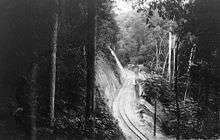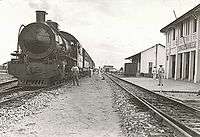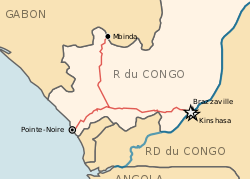Congo–Ocean Railway
| Congo-Ocean Railway line | |||
|---|---|---|---|
| Overview | |||
| System | Non-Electrified | ||
| Status | Operational | ||
| Locale | Pointe Noire, Bouenza, Kouilou, Niari, Pool, Lékoumou | ||
| Termini |
Pointe Noire Brazzaville | ||
| Stations | 49 | ||
| Services | Via Dolisie | ||
| Operation | |||
| Opened | 1934 | ||
| Character | At-grade | ||
| Technical | |||
| Line length | 512 km (318 mi) | ||
| Number of tracks | 1 | ||
| Track gauge | 1,067 mm (3 ft 6 in) | ||
| Electrification | No | ||
| Operating speed | 40 kilometres per hour (25 mph) | ||
| |||
The Congo–Ocean Railway (COR; French: Chemin de fer Congo-Océan, CFCO) links the Atlantic port of Pointe-Noire (now in the Republic of Congo) with Brazzaville, a distance of 502 kilometres (312 mi). It bypasses the rapids on the lower Congo River; from Brazzaville, river boats are able to ascend the Congo River and its major tributaries, including the Oubangui River to Bangui.
As of 2012 the railroad was regularly operating freight and passenger services along the length of the line despite the poor state of the track.[1] A luxury passenger train, La Gazelle, using Korean-manufactured passenger cars, was introduced in 2012; as of 2014 it operated between Pointe-Noire and Brazzaville every other day, and was scheduled to take 14–16 hours to complete the 502 kilometres (312 mi) journey.[2]
History



Under French colonial administration, in 1921 they contracted Société de Construction des Batignolles to construct the railway using forced labour, recruited from what is now southern Chad and the Central African Republic. Like Spain and Portugal, France did not ratify the International Labour Organisation Forced Labour Convention of 1930, No. 29.[3] Disdain among the native population towards this conscripted labour and other forms of oppression lead to the Kongo-Wara rebellion between 1928 and 1931.[4] Through the period of construction until 1934 there was a continual heavy cost in human lives, with total deaths estimated in excess of 17,000 of the construction workers, from a combination of both industrial accidents and diseases including malaria.[5] In 1946, France ratified ILO No.29, in light of a permanent state of emergency, due to indigenous revolt.
The line includes the 1,690-metre (1,850 yd) Bamba tunnel and 14 large reinforced concrete viaducts. The steepest eastbound gradients are 1 in 67, the steepest westbound 1 in 50. The initial locomotives were 2-8-2 tender and articulated tank engines with six driving axles. There were also 2 4-wheel petrol cars for engineers and an 18-passenger Micheline and another Micheline for the Governor General.[6]
In 1962, a branch was constructed to Mbinda near the border with Gabon, to connect with the COMILOG Cableway and thus carry manganese ore to Pointe-Noire. The Cableway closed in 1986 when neighbouring Gabon built its own railway to haul this traffic. The branch line remains active nonetheless.
The Congo–Ocean Railway was a user of the Golwé locomotive. Motive power is now provided by diesel locomotives.
From the start of the civil war in 1997, the line was closed for six years.
Present
COR is a state-owned enterprise whose privatization was planned as part of the commitments made by the Congolese government to the World Bank and the International Monetary Fund. Among the candidates were several consortia, including Congo-Rail (Bolloré Investments, Maersk, SNCF), and the South African consortium Sheltam Mvela.
Operations restarted in 2004, but in August 2007 BBC News reported that COR was in a "decrepit state, with the majority of trains now broken", after UNICEF had organised a train to distribute malaria nets.[7] In 2007, a Korean-led consortium CMKC Group signed a deal to build railway extensions to Ouesso and Djambala mainly for timber traffic.[8]
On 22 June 2010, a train of the Congo–Ocean Railroad was involved in a major incident, in which at least 60 people were killed. The train is believed to have derailed as it went round a curve in a remote area between Bilinga and Tchitondi, throwing four carriages into a ravine. The dead and wounded were taken to hospitals and morgues in Pointe-Noire.
In 2011, it was announced that Africa Iron was close to concluding a 25-year ore transport deal with Congo–Ocean.[9] In early 2015 the Congo-Ocean Railway purchased 10 EMD GT38AC locomotives from Electro-Motive Diesel in Muncie, Indiana. They were put into service by the summer of 2015.[10]
In the media
In 2012 the Congo–Ocean Railway was featured in an episode of the television series Chris Tarrant: Extreme Railways.[1]
Stations served
| Congo–Ocean Railway Chemin de fer Congo-Océan | |||||||||||||||||||||||||||||||||||||||||||||||||||||||||||||||||||||||||||||||||||||||||||||||||||||||||||||||||||||||||||||||||||||||||||||||||||||||||||||||||||||||||||||||||||||||||||||||||||||||||||||||||||||||||||||||||||||||||||||||||||||||||||||||||||||||||||||||||||||||||||||||||||||||||||||||||||||||||||||||||||||||||||||||||||||||||||||||||||||||||||||||||||||||||||||||||||||||||||||||||||
|---|---|---|---|---|---|---|---|---|---|---|---|---|---|---|---|---|---|---|---|---|---|---|---|---|---|---|---|---|---|---|---|---|---|---|---|---|---|---|---|---|---|---|---|---|---|---|---|---|---|---|---|---|---|---|---|---|---|---|---|---|---|---|---|---|---|---|---|---|---|---|---|---|---|---|---|---|---|---|---|---|---|---|---|---|---|---|---|---|---|---|---|---|---|---|---|---|---|---|---|---|---|---|---|---|---|---|---|---|---|---|---|---|---|---|---|---|---|---|---|---|---|---|---|---|---|---|---|---|---|---|---|---|---|---|---|---|---|---|---|---|---|---|---|---|---|---|---|---|---|---|---|---|---|---|---|---|---|---|---|---|---|---|---|---|---|---|---|---|---|---|---|---|---|---|---|---|---|---|---|---|---|---|---|---|---|---|---|---|---|---|---|---|---|---|---|---|---|---|---|---|---|---|---|---|---|---|---|---|---|---|---|---|---|---|---|---|---|---|---|---|---|---|---|---|---|---|---|---|---|---|---|---|---|---|---|---|---|---|---|---|---|---|---|---|---|---|---|---|---|---|---|---|---|---|---|---|---|---|---|---|---|---|---|---|---|---|---|---|---|---|---|---|---|---|---|---|---|---|---|---|---|---|---|---|---|---|---|---|---|---|---|---|---|---|---|---|---|---|---|---|---|---|---|---|---|---|---|---|---|---|---|---|---|---|---|---|---|---|---|---|---|---|---|---|---|---|---|---|---|---|---|---|---|---|---|---|---|---|---|---|---|---|---|---|---|---|---|---|---|---|---|---|---|---|---|---|---|---|---|---|---|---|---|---|---|---|---|---|---|---|---|---|---|---|---|---|---|---|---|---|---|---|---|---|---|---|---|---|---|---|---|---|---|---|---|---|---|---|---|---|---|---|---|
| Technical | |||||||||||||||||||||||||||||||||||||||||||||||||||||||||||||||||||||||||||||||||||||||||||||||||||||||||||||||||||||||||||||||||||||||||||||||||||||||||||||||||||||||||||||||||||||||||||||||||||||||||||||||||||||||||||||||||||||||||||||||||||||||||||||||||||||||||||||||||||||||||||||||||||||||||||||||||||||||||||||||||||||||||||||||||||||||||||||||||||||||||||||||||||||||||||||||||||||||||||||||||||
| Line length | 512 km / 318 mi | ||||||||||||||||||||||||||||||||||||||||||||||||||||||||||||||||||||||||||||||||||||||||||||||||||||||||||||||||||||||||||||||||||||||||||||||||||||||||||||||||||||||||||||||||||||||||||||||||||||||||||||||||||||||||||||||||||||||||||||||||||||||||||||||||||||||||||||||||||||||||||||||||||||||||||||||||||||||||||||||||||||||||||||||||||||||||||||||||||||||||||||||||||||||||||||||||||||||||||||||||||
| Track gauge | 1067 mm / 3 ft 6 in | ||||||||||||||||||||||||||||||||||||||||||||||||||||||||||||||||||||||||||||||||||||||||||||||||||||||||||||||||||||||||||||||||||||||||||||||||||||||||||||||||||||||||||||||||||||||||||||||||||||||||||||||||||||||||||||||||||||||||||||||||||||||||||||||||||||||||||||||||||||||||||||||||||||||||||||||||||||||||||||||||||||||||||||||||||||||||||||||||||||||||||||||||||||||||||||||||||||||||||||||||||
| |||||||||||||||||||||||||||||||||||||||||||||||||||||||||||||||||||||||||||||||||||||||||||||||||||||||||||||||||||||||||||||||||||||||||||||||||||||||||||||||||||||||||||||||||||||||||||||||||||||||||||||||||||||||||||||||||||||||||||||||||||||||||||||||||||||||||||||||||||||||||||||||||||||||||||||||||||||||||||||||||||||||||||||||||||||||||||||||||||||||||||||||||||||||||||||||||||||||||||||||||||
| COMILOG-Line | |||||||||||||||||||||||||||||||||||||||||||||||||||||||||||||||||||||||||||||||||||||||||||||||||||||||||||||||||||||||||||||||||||||||||||||||||||||||||||||||||||||||||||||||||||||||||||||||||||||||||||||||||||||||||
|---|---|---|---|---|---|---|---|---|---|---|---|---|---|---|---|---|---|---|---|---|---|---|---|---|---|---|---|---|---|---|---|---|---|---|---|---|---|---|---|---|---|---|---|---|---|---|---|---|---|---|---|---|---|---|---|---|---|---|---|---|---|---|---|---|---|---|---|---|---|---|---|---|---|---|---|---|---|---|---|---|---|---|---|---|---|---|---|---|---|---|---|---|---|---|---|---|---|---|---|---|---|---|---|---|---|---|---|---|---|---|---|---|---|---|---|---|---|---|---|---|---|---|---|---|---|---|---|---|---|---|---|---|---|---|---|---|---|---|---|---|---|---|---|---|---|---|---|---|---|---|---|---|---|---|---|---|---|---|---|---|---|---|---|---|---|---|---|---|---|---|---|---|---|---|---|---|---|---|---|---|---|---|---|---|---|---|---|---|---|---|---|---|---|---|---|---|---|---|---|---|---|---|---|---|---|---|---|---|---|---|---|---|---|---|---|---|---|
| Technical | |||||||||||||||||||||||||||||||||||||||||||||||||||||||||||||||||||||||||||||||||||||||||||||||||||||||||||||||||||||||||||||||||||||||||||||||||||||||||||||||||||||||||||||||||||||||||||||||||||||||||||||||||||||||||
| Line length | 285 km / 177 mi | ||||||||||||||||||||||||||||||||||||||||||||||||||||||||||||||||||||||||||||||||||||||||||||||||||||||||||||||||||||||||||||||||||||||||||||||||||||||||||||||||||||||||||||||||||||||||||||||||||||||||||||||||||||||||
| Track gauge | 1067 mm / 3 ft 6 in | ||||||||||||||||||||||||||||||||||||||||||||||||||||||||||||||||||||||||||||||||||||||||||||||||||||||||||||||||||||||||||||||||||||||||||||||||||||||||||||||||||||||||||||||||||||||||||||||||||||||||||||||||||||||||
| |||||||||||||||||||||||||||||||||||||||||||||||||||||||||||||||||||||||||||||||||||||||||||||||||||||||||||||||||||||||||||||||||||||||||||||||||||||||||||||||||||||||||||||||||||||||||||||||||||||||||||||||||||||||||
Specifications
- Track gauge : 3 ft 6 in (1,067 mm) gauge[12]
- Brake (railway): Vacuum brake[12]
- Coupler: SA3 coupler[12]
Railway links to adjacent countries
- Democratic Republic of the Congo - no - same gauge 1,067 mm (3 ft 6 in)
- Angola (Cabinda) - no - same gauge 1,067 mm (3 ft 6 in)
- Gabon - no - break of gauge 1,067 mm (3 ft 6 in)/1,435 mm (4 ft 8 1⁄2 in)
- Cameroon - no - break of gauge 1,067 mm (3 ft 6 in)/1,000 mm (3 ft 3 3⁄8 in)
- Central African Republic - no - no railways
Maps
Cities served by rail
See also
References
- 1 2 "Extreme Railways: Congos Jungle Railway". YouTube. 2012.
- ↑ "2014 Timetable". Lonely Planet.
- ↑ "ILO Forced Labour Convention, 1930 (No. 29)".
- ↑ "Republic of Congo profile: Timeline". BBC News. Retrieved 12 September 2017.
- ↑ "In pictures: Malaria train, Mayomba forest". news.bbc.co.uk. Retrieved 9 December 2009.
- ↑ Railway Magazine: 400. June 1936. Missing or empty
|title=(help) - ↑ "In pictures: Malaria train, Train engine". news.bbc.co.uk. Retrieved 9 December 2009.
- ↑ "Korea to build railroad in Congo". Korean Consortium. Archived from the original on 25 October 2008. Retrieved 9 December 2009.
- ↑ "Railway Gazette: News in Brief". 16 April 2011. Retrieved 16 April 2011.
- ↑ Denton, Paul (2015). "Locos For All Conditions". Railway Gazette International. London, England: DVV Media UK Ltd. 171 (6): 50.
- 1 2 "map". Archived from the original on 6 July 2011. Retrieved 13 May 2010.
- 1 2 3 Jane's World Railways (69/70 ed.). pp. 542–543.
Further reading
- Gide, André (1926). Voyage au Congo.
- Londres, Albert (1929). Terre d'Ébène.
- Sautter, Gilles (1967). "Notes sur la construction du chemin de fer Congo-Océan (1921-1934)". Cahiers d'Études africaines. 7: 219–299. doi:10.3406/cea.1967.3098 – via Persee.fr.

External links
| Wikivoyage has a travel guide for Republic of the Congo. |
| YouTube video clips | |
| Chris Tarrant Extreme Railways S01E01 - Congo |
